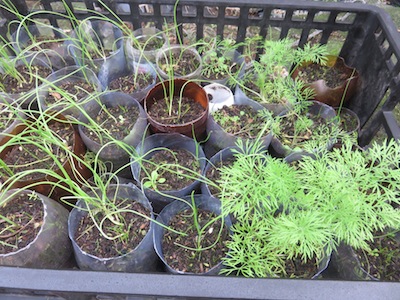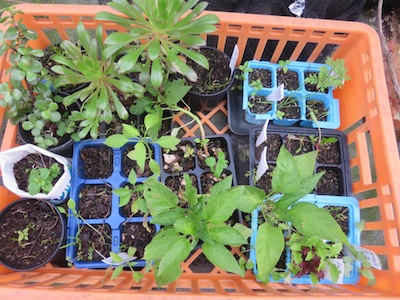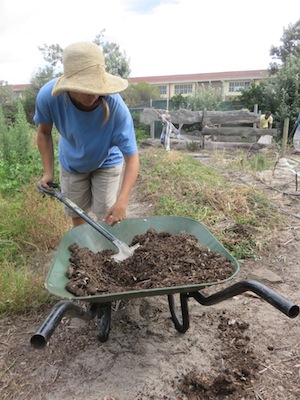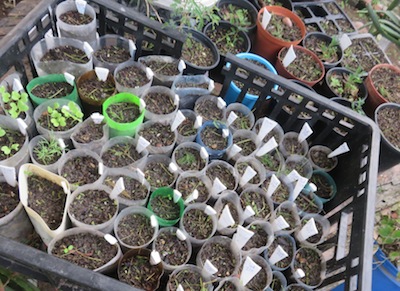how can we make a small kitchen garden highly productive and environmentally
and economically significant
 to up output of small kitchen garden: onions and dill growing on in tubes maximizes use of bed space, reduces transplant shock
to up output of small kitchen garden: onions and dill growing on in tubes maximizes use of bed space, reduces transplant shockThe context is personal, my small small small kitchen garden
My small kitchen garden is a laboratory. I've said this before and I'm still reading and experimenting with all my energy to make a my backyard garden MUCH more productive and even earn a little cash. Its a struggle, and this is a good thing, because it shows that its just not easy, and what I learn will be appreciated, and make a difference to someone.
I started growing veg only a year ago seriously. I’m going through my first year and struggling to maintain year round productivity. The goal is not even self sufficiency. The goal is to be using my plot fully. I’ve only 5 meter squared to work with. I also started growing indigenous trees recently. That has been even tougher, the propagation, just getting germination. The seeds of our local trees seem to have all kinds of inhibitors, unlike plants from other climes, as growing oaks has been a doddle by comparison. Once they germinate there is the painfully slow growth, but it is cold now.
 One picture, five stories. Background: hotspot with desert plants and indi veg, right: future forest of olive saplings, tears shed, now brown thorns prevent canine ravaging (bone meal), foreground: luxuriant cabbages but little else growing in this season, and weed freedom from occultation
One picture, five stories. Background: hotspot with desert plants and indi veg, right: future forest of olive saplings, tears shed, now brown thorns prevent canine ravaging (bone meal), foreground: luxuriant cabbages but little else growing in this season, and weed freedom from occultationThe NEED
I can plant up a small kitchen garden nicely, get things to grow with my super-compost, sow, mulch and lay weed free beds. But there is something missing in the planning of it all. Some engine that is failing in the ‘output’ of green material, because...
A few months later and some plants are done and there are holes everywhere of naked earth and the next batch of seedlings is just sulking in the ground/propagation tray. The result is that the tiny plot is empty most of the time, and we buy in 90% of our veggies still.
 waiting mix of indigenous, water/wise and Mexican/Madagascan
waiting mix of indigenous, water/wise and Mexican/MadagascanThe issues I see
in a small kitchen garden
Seasonal planting time tables, planting succession, companion planting and crop rotation must all be borne in mind. From working for Karen Parkin, a permaculturist with decades of vegetable gardening experience, I got a peep at how to do successions. She had a tiny propagation space in seed frames and kept a large vegetable garden stuffed with food plants the whole year. SEED taught me vegetable bed preparation hacks that eliminate weeding for ages.
Growing veggies for a season has highlighted some issues with root vegetables. Organic farmers say you need space without any weeds, preferably plantless, to make decent sized carrots etc. Carrots need depth, which is blocked by my cardboard using weed occultation process. Some simple carrot hacks will fix this I'm sure. The leaf vegetables do well when crowded, but I can't do dense mixed planting without compromising the root harvest. Still so much to learn. Pete Staley, a local teacher of permaculture, is doing workshops on market garden management but its so large scale by comparison to what the average small kitchen garden needs. The systems probably work with a lot more ‘empty space’, and space on a micro scale is the most valuable commodity.
 We make hot compost, the small kitchen garden turbo-charger, and then chillax
We make hot compost, the small kitchen garden turbo-charger, and then chillaxDon't you all feel it ?
BUT WHAT'S ITS NAME
I am sure what I’m concerned about is of interest to every market gardener, small kitchen garden owner, guerrilla gardener, farmer, and gardening NGO, if there is a name for it. I slowly became aware of this problem and began tentative enquiries. I found out about Tyisa Nabanye and OZCF (two local urban farms) and when I quizzed one of those involved about succession it seemed to me this particular aspect of the productivity thing doesn’t have a name. It is not bandied about, it is just known. Those who know may feel it is too complex to teach, or that its such a no brainer that it can't be taught. Each plot of land may need a different strategy, making any kind of rule not applicable in most scenarios. I do not have an answer as to why it is not taught. Teachers will know that. But for me it is the nagging issue, the thorn in my flesh, the frustration left after the other stuff is internalized.
When I've gone out learning, it seems to me that teaching is focused on the natural and how that is productive, as there is so MUCH prejudice to be overcome on this matter. So this naturalness is the concern more than the productivity per area and hour, the crude productivity, so to speak, and when crude productivity is addressed its on a large scale. But the dynamics of micro scale are so different, the parameters and values so different. Time and labor is cheaper (its our own time, and our beloved plot of ground, so we work more intensively) but surface area is at a premium. Knowledge is lacking as pressure is lacking. We are all just not on the level of 'business' with its hard parameters that drive research and optimization. So there is this tension between the parameters into which micro farming just disappears somehow. Its a struggle just to get people involved in growing vegetables, on the one hand, and there are too many urgent high level political concerns on the other, such as large scale food security activism. I find myself falling into the hole between, if it exists. Maybe its my own hole and I'm digging myself in there with gusto and ignorance. I hope then, soon to discover a teacher who will revolutionize my small kitchen garden.
 I've a name and date for all these, but not the governing principle
I've a name and date for all these, but not the governing principleI'm fishing for a name
and an M.O.
for small kitchen garden farming
I wrote a few articles about the organizing and planning of productivity as I was fishing for, trying to find a ‘method’ or something to work by, approaching it from various angles. I wrote about succession ‘on demand’, with a diverse backlog of larger seedlings waiting…which I'd got from observing Karin
https://www.greenidiom.com/vegetable-garden-planner.html
Also some gardeners have amazing diversity on a small scale. I saw this in a permaculture video I can’t trace right now, this gardener had 200 species of trees in a tiny garden, so I wrote on how one could mix all kinds of useful plants in this article, and pack them into a small space, and practice ‘micro-conservation’.
https://www.greenidiom.com/urban-gardening.html
And how olives could take the position of the climax vegetation in Cape (Mediterranean) food gardens
https://www.greenidiom.com/olive-propagation.html
And how to space mixed plantings in an organic way
https://www.greenidiom.com/herb-garden-design.html
What "it" offers
beyond the small kitchen garden
If one could find out oneself, and also teach other people with a small kitchen garden to make produce all year round, in a relatively effortless way, it would be amazing. This is the goal of permaculture, productivity without harm, and with minimum fuss, by recreating self-sustaining ecosystems. So we’re taught how to do it the natural way, and within ecosystemic thinking and design. This is fantastic, revolutionary and something I identify with profoundly. But how to ramp it up to an intense level of yield, on a tiny scale, such as that of a small kitchen garden, I haven’t found. I’ve heard of the door sized garden based on buried refuse, so one can squeeze in an amazing amount of food on two square meters, but does it maintain year round productivity ? Are the carrots miniscule ? I have not tried it, so I'm ignorant. I’m coming to the conclusion that each has to find out for himself. Each must find a solution for their own small kitchen garden. If this knowledge were easy to get, food security problems would be solved. Snipes about permaculture not producing enough yield, in certain circles, would be silenced.
 pretty, shot in the foot. Garden no longer flat and dome friendly
pretty, shot in the foot. Garden no longer flat and dome friendlyWho (else) dunnit ?
I read a book by an Australian permie who is self sufficient and selling too on a larger highly productive effort efficient piece of land. She has, I think, three clusters of 7 circular beds and three 5m chicken domes in constant circulation, so she must have at least 1000 square meters. Her plants go in well grown on and large and come out at harvest in a 3 month rhythm and the beds are cleared by chickens in 2 weeks and then planted again. To pump up productivity she uses a system of planting in tubes, so there is never any ‘transplanting’ and the consequent slow down. This tube system is seen in many places locally too. I’m practicing it now, but it remains to be seen how effective it really is, and if my small scale and lack of flat terrain and consequent chicken dearth is the limiting factor. The minute you aren’t ‘market garden’ size this possibility of productivity drops. I’ve seen people here like the Guerilla house and SEED activists do amazing things and find creative low budget, small scale solutions, so I almost know they've got this whacked and perhaps just call it by a different name.
 future flourishing tree nursery in my small kitchen garden
future flourishing tree nursery in my small kitchen gardenNaming: just a game
Ok, I hope after this circuitous ramble that I can give this a name, and you’ll have a picture of what I’m driving at when I use it. To aim for self sufficiency would be its goal, and this would be amazing but sometimes it just sets one up for being disappointed with one’s cabbage patch in some season or other !! So lets call it: natural intense conservational micro productivity ... eh...no, what a mouthful. It includes year round kitchen garden productivity making the most of the square meterage you have in your back garden without using chemicals, and without it breaking your back, and also includes the conservation of local indigenous plants as far as possible. Lets try again intensive small garden eco-farming and micro-conservation... to long... I would call it Edenic gardening but that is already taken and does not imply smallness or high productivity. Paradise garden implies a man made enclosure around a food forest with Eden like qualities (the old Persian origin of the name means 'walled around' and the idea goes back to 4000 BC or so). A great name except no smallness implied, and taken over by the decorative high maintenance gardening school. In the short term I'll just call it Evo's gardening, mixing Eve's (she made up for lack of physical diligence with curiosity), ecological, economical (with a centrally placed V for vegetables), evolved (as in turbo charged V in my dream), avos (from the big tree of the central American food forests of the Maya) and 's for small and privately possessed. I'm thinking there isn't much of a claim on the name, though I love these folk, whoever they are. They don't make their names, mission, non profit or corporate identity too clear. This name is just a draft, to give this vague idea substance so that it can gather focus and knowledge around it.
EVO's ?
I’d also like to sell trees, the foundation of the paradise garden of old old Persia, I'm a tree devotee. I’ve a lot of trees, but Kirstenbosch (our national botanical garden) said I could not supply them without a horticultural or nurseryman’s license, so its hard to sell plants on a small scale and survive. I can’t afford licenses at this level, so the project would partly be about how to go about marketing horticultural stuff and knowledge in a small is beautiful mode. This a separate issue perhaps. But it is the other side of the coin. A tiny garden in an urban space implies need for other income. To me its part of productivity and making this work.
------
home page for a flood of information and explorations on natural gardening
------
vegetable gardening the natural low cost way
Restore Nature Newsletter
I've been writing for four years now and I would love to hear from you
Please let me know if you have any questions, comments or stories to share on gardening, permaculture, regenerative agriculture, food forests, natural gardening, do nothing gardening, observations about pests and diseases, foraging, dealing with and using weeds constructively, composting and going offgrid.
SEARCH
Order the Kindle E-book for the SPECIAL PRICE of only
Prices valid till 30.09.2023
Recent Articles
-
Rose
Dec 17, 23 04:08 AM
I am doing research on growing wildlife foraging plants to use in enhancement plantings with wildlife in mind. My thoughts after seeing bears too skinny -
Seeds for a bred Sweeter less acidic Kei apple
Nov 20, 23 03:24 AM
Greetings Greenidiom, I'm a small farmer in kenya. I'm looking to plant a Green fence around a 6 acre plot of land and, I'd wish to make it of kei apples -
Mrs Laura Robinson
Oct 08, 23 02:17 AM
How do I get a copy of the soil aggregation poster??
"How to start a profitable worm business on a shoestring budget
Order a printed copy from "Amazon" at the SPECIAL PRICE of only
or a digital version from the "Kindle" store at the SPECIAL PRICE of only
Prices valid till 30.09.2023






